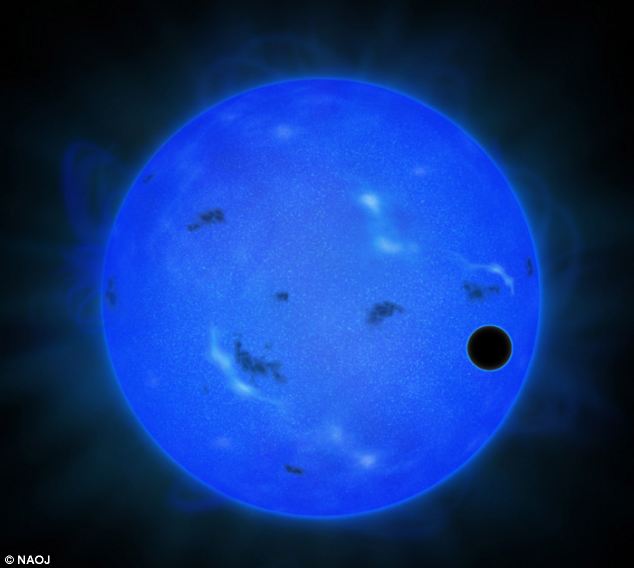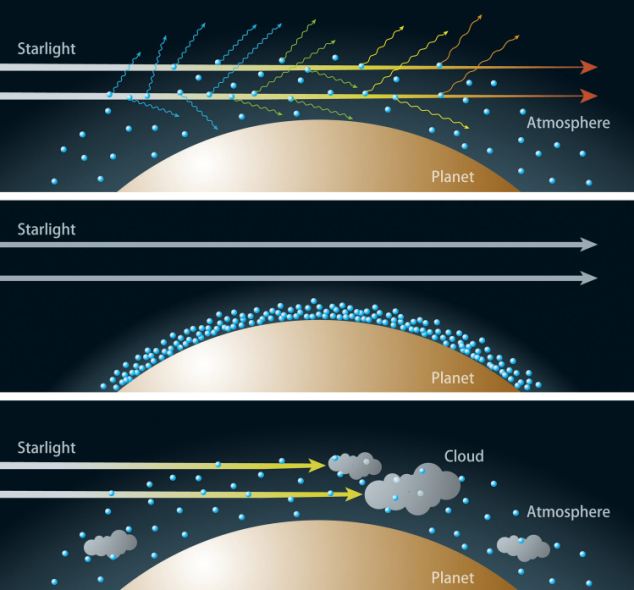Super-Earth 40 light years away 'is rich in water with a thick,
steamy atmosphere', confirm Japanese astronomers
- GJ 1214b is 2.6 times Earth’s diameter and weighs seven times as much
- It was first discovered as part of the ground-based MEarth Project in 2009
- The observations by the Subaru telescope could help scientists find out more about the planet's birthplace and formation history
Blue light observations of a super-Earth 40 light years from our planet suggest that it is a world with a thick, steamy water-rich atmosphere.
Japanese astronomers used the Subaru telescope to observe planetary transits of the super-Earth, which is located at the centre of the Milky Way.
Astronomers had previously confirmed that this alien world has a thick atmosphere, but were unable to determine whether the atmosphere was primarily hydrogen or a steamy soup of water vapour.
Their findings confirm that the super-Earth has an atmosphere rich in water rather than hydrogen.

Artist's rendition of a transit of GJ 1214 b in blue light. The blue sphere represents the host star GJ 1214, and the black ball in front of it on the right is GJ 1214 b
SUPER-EARTH GJ
1214B
The water world, named GJ
1214b is one of the more well-known super-Earths and was
discovered by the ground-based MEarth Project in 2009.
This super-Earth is about 2.6 times Earth’s diameter and weighs almost seven times as much.
It orbits a red-dwarf star every 38 hours at a distance of 2 million kilometres, giving it an estimated temperature of 230 degrees Celsius.
Astronomers had previously confirmed that this alien world has a thick atmosphere, but were unable to determine whether the atmosphere was primarily hydrogen or a steamy soup of water vapour.
Super-Earths are exoplanets orbiting a star outside of the solar system that are larger than Earth's but smaller than those of ice giants such as Uranus or Neptune.
Their planetary transits enable
scientists to find changes in the wavelength in the brightness of the
star, which indicate the planet's atmospheric composition.
If scientists can determine the major atmospheric component of a super-Earth, they can then find out the planet's birthplace and formation history.
The water world, named GJ 1214b is
one of the more well-known super-Earths and was discovered by the
ground-based MEarth Project in 2009.
This super-Earth is about 2.6 times
Earth’s diameter and weighs almost seven times as much.

If the sky has a hydrogen-dominated atmosphere (as shown in the top image) Rayleigh scattering disperses blue light from the atmosphere of the host. The middle image shows how Rayleigh scattering is much weaker in water-rich atmospheres while the bottom image show what would happen if the sky had extensive clouds
It orbits a red-dwarf star every 38 hours at a distance of 2 million kilometres, giving it an estimated temperature of 230 degrees Celsius.
Last year, the Hubble space telescope examined GJ 1214b when it crossed in front of its host star.
During such a transit, the star’s
light is filtered through the planet’s atmosphere, giving clues to the
mix of gases.
They found the spectrum of GJ 1214b
to be featureless over a wide range of wavelengths, or colours, also
suggesting the planet had a dense atmosphere of water vapour.

The planet GJ 1214b, shown here in an artist's conception with two hypothetical moons, orbits a star 40 light-years from Earth. The super-Earth is about 2.6 times Earth's diameter and weighs seven times as much
Subaru found weak Rayleigh scattering in the optical wavelength which the team claim provided ‘powerful evidence’ for a water-dominated atmosphere.
Another possibility for the weak
Rayleigh scattering is that the planet has a hydrogen-dominated
atmosphere with extensive clouds.
Rayleigh scattering occurs when light particles scatter in a medium without a change in wavelength.
In a water-rich atmosphere, such as
the one on GJ 1214b, the effect of the Rayleigh scattering is much
weaker than in a hydrogen-dominated atmosphere.
Up until now, more than 800
exoplanets have been discovered and around so far and 12 are thought to
have the environments that could be habitable.
More unusual discoveries include a
planet that is as airy as Styrofoam, and another that rains glass.
Researchers claim there could be as
many as 100 billion Earth-like planets in the Milky Way.
Astronomers, however, claim the temperature on GJ 1214b is probably far too high for life to exist there.
Blue light observations of a super-Earth 40 light years from our planet suggest that it is a world with a thick, steamy water-rich atmosphere.
Japanese astronomers used the Subaru telescope to observe planetary transits of the super-Earth, which is located at the centre of the Milky Way.
Astronomers had previously confirmed that this alien world has a thick atmosphere, but were unable to determine whether the atmosphere was primarily hydrogen or a steamy soup of water vapour.
Their findings confirm that the super-Earth has an atmosphere rich in water rather than hydrogen.

Artist's rendition of a transit of GJ 1214 b in blue light. The blue sphere represents the host star GJ 1214, and the black ball in front of it on the right is GJ 1214 b
SUPER-EARTH GJ
1214B
The water world, named GJ
1214b is one of the more well-known super-Earths and was
discovered by the ground-based MEarth Project in 2009.
This super-Earth is about 2.6 times Earth’s diameter and weighs almost seven times as much.
It orbits a red-dwarf star every 38 hours at a distance of 2 million kilometres, giving it an estimated temperature of 230 degrees Celsius.
Astronomers had previously confirmed that this alien world has a thick atmosphere, but were unable to determine whether the atmosphere was primarily hydrogen or a steamy soup of water vapour.
Super-Earths are exoplanets orbiting a star outside of the solar system that are larger than Earth's but smaller than those of ice giants such as Uranus or Neptune.
Their planetary transits enable
scientists to find changes in the wavelength in the brightness of the
star, which indicate the planet's atmospheric composition.
If scientists can determine the major atmospheric component of a super-Earth, they can then find out the planet's birthplace and formation history.
The water world, named GJ 1214b is
one of the more well-known super-Earths and was discovered by the
ground-based MEarth Project in 2009.
This super-Earth is about 2.6 times
Earth’s diameter and weighs almost seven times as much.

If the sky has a hydrogen-dominated atmosphere (as shown in the top image) Rayleigh scattering disperses blue light from the atmosphere of the host. The middle image shows how Rayleigh scattering is much weaker in water-rich atmospheres while the bottom image show what would happen if the sky had extensive clouds
It orbits a red-dwarf star every 38 hours at a distance of 2 million kilometres, giving it an estimated temperature of 230 degrees Celsius.
Last year, the Hubble space telescope examined GJ 1214b when it crossed in front of its host star.
During such a transit, the star’s
light is filtered through the planet’s atmosphere, giving clues to the
mix of gases.
They found the spectrum of GJ 1214b
to be featureless over a wide range of wavelengths, or colours, also
suggesting the planet had a dense atmosphere of water vapour.

The planet GJ 1214b, shown here in an artist's conception with two hypothetical moons, orbits a star 40 light-years from Earth. The super-Earth is about 2.6 times Earth's diameter and weighs seven times as much
Subaru found weak Rayleigh scattering in the optical wavelength which the team claim provided ‘powerful evidence’ for a water-dominated atmosphere.
Another possibility for the weak
Rayleigh scattering is that the planet has a hydrogen-dominated
atmosphere with extensive clouds.
Rayleigh scattering occurs when light particles scatter in a medium without a change in wavelength.
In a water-rich atmosphere, such as
the one on GJ 1214b, the effect of the Rayleigh scattering is much
weaker than in a hydrogen-dominated atmosphere.
Up until now, more than 800
exoplanets have been discovered and around so far and 12 are thought to
have the environments that could be habitable.
More unusual discoveries include a
planet that is as airy as Styrofoam, and another that rains glass.
Researchers claim there could be as
many as 100 billion Earth-like planets in the Milky Way.
Astronomers, however, claim the temperature on GJ 1214b is probably far too high for life to exist there.